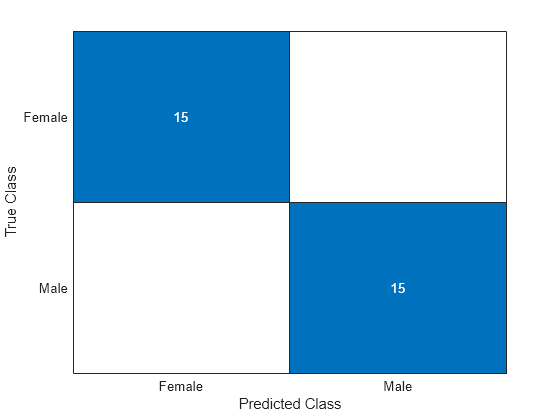transform
Description
NewTbl = transform(Transformer,Tbl)FeatureTransformer object Transformer. The input
Tbl must contain the required variables, whose data types must match
those of the variables originally passed to gencfeatures or
genrfeatures when
Transformer was created.
NewTbl = transform(Transformer,Tbl,Index)Index indicates the
features to return.
Examples
Generate features to train a linear regression model. Compute the cross-validation mean squared error (MSE) of the model by using the crossval function.
Load the patients data set, and create a table containing the predictor data.
load patients Tbl = table(Age,Diastolic,Gender,Height,SelfAssessedHealthStatus, ... Smoker,Weight);
Create a random partition for 5-fold cross-validation.
rng("default") % For reproducibility of the partition cvp = cvpartition(size(Tbl,1),KFold=5);
Compute the cross-validation MSE for a linear regression model trained on the original features in Tbl and the Systolic response variable.
CVMdl = fitrlinear(Tbl,Systolic,CVPartition=cvp); cvloss = kfoldLoss(CVMdl)
cvloss = 45.2990
Create the custom function myloss (shown at the end of this example). This function generates 20 features from the training data, and then applies the same training set transformations to the test data. The function then fits a linear regression model to the training data and computes the test set MSE.
Note: If you use the live script file for this example, the myloss function is already included at the end of the file. Otherwise, you need to create this function at the end of your .m file or add it as a file on the MATLAB® path.
Compute the cross-validation MSE for a linear model trained on features generated from the predictors in Tbl.
newcvloss = mean(crossval(@myloss,Tbl,Systolic,Partition=cvp))
newcvloss = 26.5048
function testloss = myloss(TrainTbl,trainY,TestTbl,testY) [Transformer,NewTrainTbl] = genrfeatures(TrainTbl,trainY,20); NewTestTbl = transform(Transformer,TestTbl); Mdl = fitrlinear(NewTrainTbl,trainY); testloss = loss(Mdl,NewTestTbl,testY); end
Train a linear classifier using only the numeric generated features returned by gencfeatures.
Load the patients data set. Create a table from a subset of the variables.
load patients Tbl = table(Age,Diastolic,Height,SelfAssessedHealthStatus, ... Smoker,Systolic,Weight,Gender);
Partition the data into training and test sets. Use approximately 70% of the observations as training data, and 30% of the observations as test data. Partition the data using cvpartition.
rng("default")
c = cvpartition(Tbl.Gender,Holdout=0.30);
TrainTbl = Tbl(training(c),:);
TestTbl = Tbl(test(c),:);Use the training data to generate 25 new features. Specify the minimum redundancy maximum relevance (MRMR) feature selection method for selecting new features.
Transformer = gencfeatures(TrainTbl,"Gender",25, ... FeatureSelectionMethod="mrmr")
Transformer =
FeatureTransformer with properties:
Type: 'classification'
TargetLearner: 'linear'
NumEngineeredFeatures: 23
NumOriginalFeatures: 2
TotalNumFeatures: 25
Inspect the generated features.
Info = describe(Transformer)
Info=25×4 table
Type IsOriginal InputVariables Transformations
___________ __________ ________________________ __________________________________________________________________________________________
zsc(Weight) Numeric true Weight "Standardization with z-score (mean = 153.1571, std = 26.8229)"
eb5(Weight) Categorical false Weight "Equal-width binning (number of bins = 5)"
c(SelfAssessedHealthStatus) Categorical true SelfAssessedHealthStatus "Variable of type categorical converted from a cell data type"
zsc(sqrt(Systolic)) Numeric false Systolic "sqrt( ) -> Standardization with z-score (mean = 11.086, std = 0.29694)"
zsc(sin(Systolic)) Numeric false Systolic "sin( ) -> Standardization with z-score (mean = -0.1303, std = 0.72575)"
zsc(Systolic./Weight) Numeric false Systolic, Weight "Systolic ./ Weight -> Standardization with z-score (mean = 0.82662, std = 0.14555)"
zsc(Age+Weight) Numeric false Age, Weight "Age + Weight -> Standardization with z-score (mean = 191.1143, std = 28.6976)"
zsc(Age./Weight) Numeric false Age, Weight "Age ./ Weight -> Standardization with z-score (mean = 0.25424, std = 0.062486)"
zsc(Diastolic.*Weight) Numeric false Diastolic, Weight "Diastolic .* Weight -> Standardization with z-score (mean = 12864.6857, std = 2731.1613)"
q6(Height) Categorical false Height "Equiprobable binning (number of bins = 6)"
zsc(Systolic+Weight) Numeric false Systolic, Weight "Systolic + Weight -> Standardization with z-score (mean = 276.1429, std = 28.7111)"
zsc(Diastolic-Weight) Numeric false Diastolic, Weight "Diastolic - Weight -> Standardization with z-score (mean = -69.4286, std = 26.2411)"
zsc(Age-Weight) Numeric false Age, Weight "Age - Weight -> Standardization with z-score (mean = -115.2, std = 27.0113)"
zsc(Height./Weight) Numeric false Height, Weight "Height ./ Weight -> Standardization with z-score (mean = 0.44797, std = 0.067992)"
zsc(Height.*Weight) Numeric false Height, Weight "Height .* Weight -> Standardization with z-score (mean = 10291.0714, std = 2111.9071)"
zsc(Diastolic+Weight) Numeric false Diastolic, Weight "Diastolic + Weight -> Standardization with z-score (mean = 236.8857, std = 29.2439)"
⋮
Transform the training and test sets, but retain only the numeric predictors.
numericIdx = (Info.Type == "Numeric");
NewTrainTbl = transform(Transformer,TrainTbl,numericIdx);
NewTestTbl = transform(Transformer,TestTbl,numericIdx);Train a linear model using the transformed training data. Visualize the accuracy of the model's test set predictions by using a confusion matrix.
Mdl = fitclinear(NewTrainTbl,TrainTbl.Gender); testLabels = predict(Mdl,NewTestTbl); confusionchart(TestTbl.Gender,testLabels)

Input Arguments
Feature transformer, specified as a FeatureTransformer object.
Features to transform, specified as a table. The rows must correspond to
observations, and the columns must correspond to the predictors used to generate the
transformed features stored in Transformer. You can enter
describe(Transformer).InputVariables to see the list of features
that Tbl must contain.
Data Types: table
Features to return, specified as a numeric or logical vector indicating the position of the features, or a string array or cell array of character vectors indicating the names of the features.
Example: 1:12
Data Types: single | double | logical | string | cell
Output Arguments
Transformed features, returned as a table. Each row corresponds to an observation, and each column corresponds to a generated feature.
Version History
Introduced in R2021a
MATLAB Command
You clicked a link that corresponds to this MATLAB command:
Run the command by entering it in the MATLAB Command Window. Web browsers do not support MATLAB commands.
选择网站
选择网站以获取翻译的可用内容,以及查看当地活动和优惠。根据您的位置,我们建议您选择:。
您也可以从以下列表中选择网站:
如何获得最佳网站性能
选择中国网站(中文或英文)以获得最佳网站性能。其他 MathWorks 国家/地区网站并未针对您所在位置的访问进行优化。
美洲
- América Latina (Español)
- Canada (English)
- United States (English)
欧洲
- Belgium (English)
- Denmark (English)
- Deutschland (Deutsch)
- España (Español)
- Finland (English)
- France (Français)
- Ireland (English)
- Italia (Italiano)
- Luxembourg (English)
- Netherlands (English)
- Norway (English)
- Österreich (Deutsch)
- Portugal (English)
- Sweden (English)
- Switzerland
- United Kingdom (English)